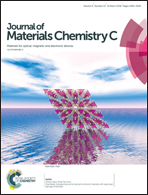Interface dipole for remarkable efficiency enhancement in all-solution-processable transparent inverted quantum dot light-emitting diodes
Abstract
We report our efforts to develop high performing all-solution-processable transparent inverted quantum-dot light-emitting diodes (QD-LEDs) by interposing an interface dipole between the ZnO electron-transporting layer (ETL) and the quantum dot light-emitting layer. This shows that the electrostatic interaction between the N+ groups in the polar conjugated polyelectrolyte molecules and the hydroxyl (OH−) groups on the ZnO ETL surface creates the interface dipole. The presence of an optimal interface dipole benefits the efficient operation of the QD-LEDs in two ways: (1) it effectively reduces the energy barrier at the ETL/QD emissive layer interface for efficient charge injection, and (2) it prevents the exciton quenching by suppression of the ZnO surface defects. The combined effects resulted in a significant enhancement in the performance of the transparent inverted QD-LED, achieving an impressive high maximum luminance of 10 011 cd m−2, which is 75% higher than that of a control device made with a pristine ZnO ETL (5721 cd m−2). The QD-LEDs with an optimal interface dipole also possess a high luminous efficiency of 1.55 cd A−1, which is 57% higher than that of a control QD-LED (0.99 cd A−1).



 Please wait while we load your content...
Please wait while we load your content...